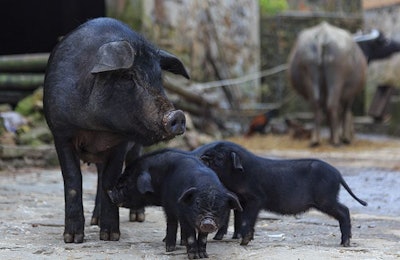
China’s swine herd reportedly suffered staggering losses over the past months, creating challenges and opportunities.
The country’s swine industry represents a significant chunk of the entire global meat supply. In 2018, China produced 17.5 billion pounds (carcass weight) of pork. That’s larger than the U.S.’ total combined output of beef, pork, chicken, and turkey during the same year.
Hog inventories in China are now severely depleted as a result of an ASF outbreak that started in August 2018 and has since become a crisis. A lack of transparency by the Chinese government undermines efforts to accurately report the scale of the problem. Conservative estimates say losses total at least 20% of China’s annualized pork production capabilities with potentially more than one-third of its pork sector wiped out.
Supply deficit sends prices soaring
China is expected to lose at least 150 million pigs and 25 to 30 billion pounds of pork output over the next six to 12 months. Losses could easily wind up much higher if containment efforts fail.
Market reactions have been fierce. Meat protein prices in China are soaring, with beef and poultry at record levels as of February 2019. This is helping push up prices globally.

As of 2018, the total production of beef, pork, chicken and turkey in the U.S. amounted to roughly 85% of Chinese pork production.
The Chicago Mercantile Exchange’s Lean Hog Index rallied from just over $50 per hundredweight in late February to more than $80 per cwt. by the end of April. During the same time period, the U.S. Department of Agriculture’s wholesale pork cutout value surged from close to $60 per cwt. to more than $85 per cwt. Comparatively, chicken leg quarters climbed from around $0.30 per pound in mid-February 2019 to more than $0.40 per lb. by mid-April 2019.
No easy solutions to filling China’s meat supply gap
China’s ASF woes aren’t a short-term issue, either. While the worst may be over within a year, animal health experts say it will take at least five years before China can eradicate the virus and return to normal. That will leave a gaping void in China’s meat supply that won’t be easily filled.
Pork producers in Brazil, Canada and the European Union stand to benefit first from this export opportunity. However, the deficit is so large China will likely be motivated to source pork from other areas of the world and import larger quantities of other proteins, too. U.S. meat companies are also poised to benefit, but trade barriers – steep import tariffs on pork and an outright ban on poultry – stand as obstacles.
Opportunity for US protein companies
Even if trade barriers aren’t removed and direct trade between the U.S. and China remains restricted, U.S. meat and poultry producers should still benefit.
As more protein is diverted to China from around the globe, opportunities should arise for U.S. meat companies to backfill product into markets that might be left short. Nearby points of entry, such as Hong Kong and Taiwan, are also likely to become critical channels for pork and poultry to flow indirectly into mainland China if trade barriers remain.
The U.S. broiler industry’s export program has languished for several years and needs a boost. Annual shipments of U.S. broiler meat increased by an average of only 0.2% over the past decade. Based on China’s unfolding deficit and its impact on global meat supplies, it’s reasonable to conclude that the ongoing ASF crisis in China could boost U.S. broiler exports by at least 500 million pounds both this year and next.
View our continuing coverage of the African swine fever outbreak.
















